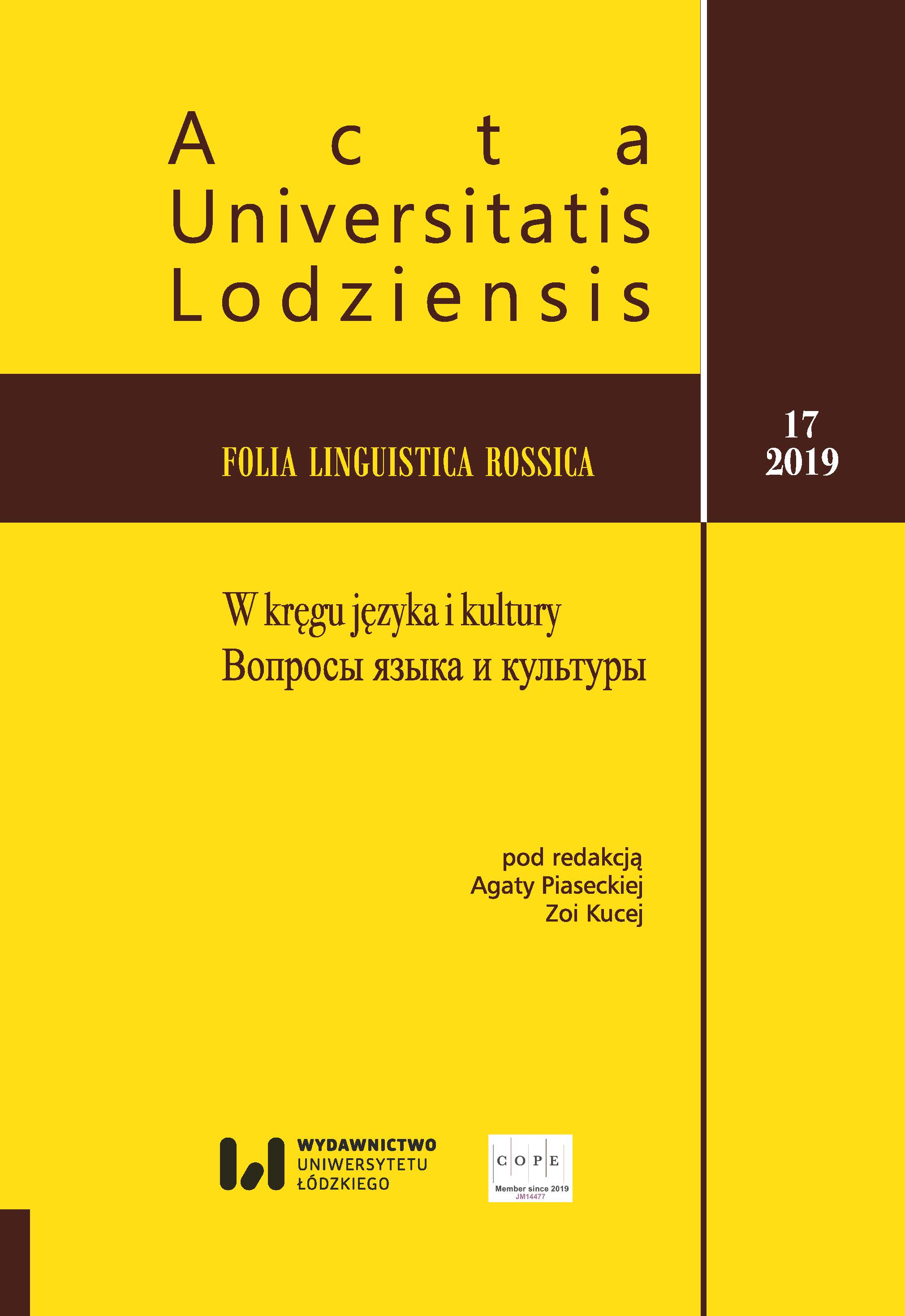Текст: уровни понимания и уровни смысла
DOI:
https://doi.org/10.18778/1731-8025.17.08Ключевые слова:
понимание, смысл, уровневая модель, интерпретация, рассказАннотация
Введение. Цель настоящего исследования: предложить типологию уровней смысла прозаического текста, которая может продуктивно использоваться в рамках педагогической герменевтики, т.е. в процессе учебной интерпретации литературных произведений на всех ступенях филологического образования.
Согласно гипотезе исследования, существует определенная корреляция между уровнями понимания текста и уровнями смысла. Медиатором между текстом и его смыслом является текстовый концепт.
В различении уровней понимания текста автор статьи следует за герменевтической (Г.И. Богин) и дидактической традицией (М.П. Воюшина). Для сравнения привлекаются работы когнитивного направления, рассматривающие понимание текста как процесс построения многоуровневой ментальной репрезентации (Van Dijk, Kintsch, Zwaan, Kneepkens). В процессе построения модели смысла текста учтены основные положения теории смысла А.И. Новикова и структура текстовой категории информативности у И.Р. Гальперина.
Материал и методы исследования. В качестве объекта исследования был выбран рассказ известного детского писателя В. Драгунского Красный шарик в синем небе. Материалом исследования послужили 30 читательских интерпретаций рассказа, выполненных студентами – будущими учителями начальных классов. Контрольная интерпретация принадлежит автору статьи. В ходе интерпретации использовалась методика ключевых слов, метод «медленного чтения» и методика ведения протокола интерпретации.
Основные результаты и выводы.
Смысл неоднократно закодирован в тексте средствами текстовых кодов (языкового, предметного, пространственного, образного, коммуникативного и др.). Процесс дешифровки смысла состоит в уяснении отношения между единицами этих кодов, обнаружении общих компонентов смысла.
Целостный смысл представляет собой результат понимания текста. Поэтому возможно установить корреляцию между уровнями смысла и уровнями понимания. Нами установлены следующие цепочки соответствий:
- сюжетный смысл – констатирующий уровень понимания – метапропозициональная модель репрезентации;
- психологический смысл – понимание на уровне героя – ситуативная модель репрезентации;
- экзистенциальный смысл – понимание на уровне авторской идеи – прагматическая модель репрезентации.
Корреляция между строением смысла и строением текста осуществляется через текстовый концепт – дискретную модель смысла как целостного образования.
Многоуровневый концепт (а именно таким является концепт свободы, репрезентированный средствами разных уровней в рассказе В. Драгунского) отражает многоуровневость текстового смысла. Поэтому уровни смысла рассказа Драгунского – это уровни свободы:
- сюжетному смыслу соответствует бытовой (условно) уровень свободы: наделить свободой – дать уйти, отпустить, не удерживать;
- психологическому смыслу (понимание на уровне героя) – психологический уровень свободы, которая требует уважать чувства и желания других;
- культурно-историческому смыслу – на уровне (возможного) подтекста соответствует идея политической свободы;
- экзистенциальному смыслу (на уровне идеи) – философский смысл свободы как высшей человеческой ценности и как проявления духовной сущности человека.
Не все аспекты текстового смысла раскрываются для современного читателя.
Неактуальное для читателей духовное измерение свободы не вычитывается из текста, и в большинстве работ понимание остается на уровне психологического смысла. Универсальность свободы как экзистенциальной категории отмечена только в трех работах. Социальных аспектов смысла не указал никто.
Таким образом, инвариантной частью смысла следует считать ту, которая отражена в базовом концепте (мотиве) текста. Это самая общая формулировка идеи. Вариантными компонентами смысла следует признать те, которые конкретизируют общий смысл на разных уровнях, с учетом проекций на личный опыт читателя: психологический, социальный, экзистенциальный, духовный. Степень вариативности формулировок этого смысла может быть различной: она зависит от концептуальной системы читателя, его жизненного, в том числе социального опыта, возраста и т.д.
Библиографические ссылки
Бердяев, Н.А. (1994). Философия творчества, культуры и искусства. Т. 1. Москва: Искусство.
Google Scholar
Богин, Г.И. (1986). Типология понимания текста. Калинин: Издательство Калининского университета.
Google Scholar
Болотнова, Н.С. (2008). Коммуникативная стилистика текста: словарь-тезаурус. Томск: Издательство Томского государственного педагогического университета.
Google Scholar
Воюшина, М.П. (ред.) (2010). Методика обучения литературе в начальной школе. Москва: Академия.
Google Scholar
Гальперин, И.Р. (2006). Текст как объект лингвистического исследования. Москва: КомКнига.
Google Scholar
Драгунский, В.Ю. (1982). Красный шарик в синем небе. Москва: Советская Россия.
Google Scholar
Евгеньева, А.П. (ред.) (1985). Словарь русского языка: в 4 т. Т. I. Москва: Русский язык.
Google Scholar
Евгеньева, А.П. (ред.) (1988). Словарь русского языка: в 4 т. Т. IV. Москва: Русский язык.
Google Scholar
Залевская, А.А. (2002). Некоторые проблемы теории понимания текста. Вопросы языкознания, 3, 6274.
Google Scholar
Лукашевич, Е.В. (2002). Когнитивная семантика: эволюционно-прогностический аспект. Москва; Барнаул: Издательство Алтайского университета.
Google Scholar
Новиков, А.И. (2007). Текст и его смысловые доминанты. Москва: Институт языкознания РАН.
Google Scholar
Синельникова, Л.Н. (2019). Стихотворный текст: междисциплинарная интерпретация. Москва: Инфра-М.
Google Scholar
Солохина, А.С. (2004). Концепт «свобода» в английской и русской лингвокультурах: автореф. дисс. … канд. филол. наук. Волгоград.
Google Scholar
Тарасова, И.А. (2003). Идиостиль Георгия Иванова: когнитивный аспект. Саратов: Издательство Саратовского университета.
Google Scholar
Фарино, Е. (2004). Введение в литературоведение. Санкт-Петербург: Издательство РГПУ им. А.И. Герцена.
Google Scholar
Dijk van T.A., Kintsch W. (1983). Strategies of Discourse Comprehension. New York: Academic Press.
Google Scholar
Kneepkens E., Zwaan R. (1994). Emotions and Literary Text Comprehension, Poetics, 23, 125138.
Google Scholar
DOI: https://doi.org/10.1016/0304-422X(94)00021-W
Berdyaev, N A. (1994). Filosofiya tvorchestva, kul’tury i iskusstva. T. 1. Moscow: Iskusstvo.
Google Scholar
Bogin, G.I. (1986). Tipologiya ponimaniya teksta. Kalinin: Izdatel’stvo Kalininskogo universiteta.
Google Scholar
Bolotnova, N.S. (2008). Kommunikativnaya stilistika teksta: slovar’-tezaurus. Tomsk: Izdatel’stvo Tomskogo gosudarstvennogo pedagogicheskogo universiteta.
Google Scholar
Dragunskii, V.Yu. (1982). Krasnyi sharik v sinem nebe. Moscow: Sovetskaya Rossiya.
Google Scholar
Evgen’eva, A.P. (red.) (1985). Slovar’ russkogo yazyka: v 4 t. T. I. Moscow: Russkii yazyk.
Google Scholar
Evgen’eva, A.P. (red.) (1988). Slovar’ russkogo yazyka: v 4 t. T. IV. Moscow: Russkii yazyk.
Google Scholar
Farino, E. (2004). Vvedenie v literaturovedenie. St. Petersburg: Izdatel’stvo RGPU im. A.I. Gertsena.
Google Scholar
Gal’perin, I.R. (2006). Tekst kak ob”ekt lingvisticheskogo issledovaniya. Moscow: KomKniga.
Google Scholar
Lukashevich, E.V. (2002). Kognitivnaya semantika: evolyutsionno-prognosticheskii aspekt. Moscow; Barnaul: Izdatel’stvo Altaiskogo universiteta.
Google Scholar
Novikov, A.I. (2007). Tekst i ego smyslovye dominanty. Moscow: Institut yazykoznaniya RAN.
Google Scholar
Sinel’nikova, L.N. (2019). Stikhotvornyi tekst: mezhdistsiplinarnaya interpretatsiya. Moscow: Infra-M.
Google Scholar
Solokhina, A.S. (2004). Kontsept „svoboda” v angliiskoi i russkoi lingvokul’turakh: avtoref. diss. … kand. filol. nauk. Volgograd.
Google Scholar
Tarasova, I.A. (2003). Idiostil’ Georgiya Ivanova: kognitivnyi aspekt. Saratov: Izdatel’stvo Saratovskogo universiteta.
Google Scholar
Voyushina, M.P. (red.) (2010). Metodika obucheniya literature v nachal’noi shkole. Moscow: Akademiya.
Google Scholar
Zalevskaya, A.A. (2002). Nekotorye problemy teorii ponimaniya teksta, Voprosy yazykoznaniya, 3, 6274.
Google Scholar
Загрузки
Опубликован
Как цитировать
Выпуск
Раздел
Лицензия

Это произведение доступно по лицензии Creative Commons «Attribution-NonCommercial-NoDerivatives» («Атрибуция — Некоммерческое использование — Без производных произведений») 4.0 Всемирная.









